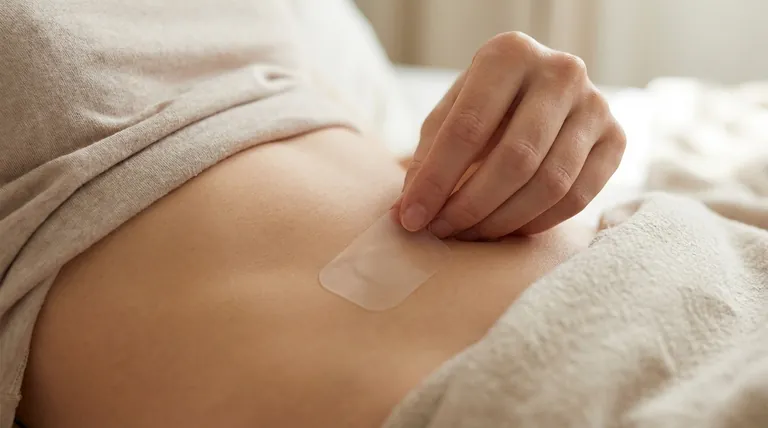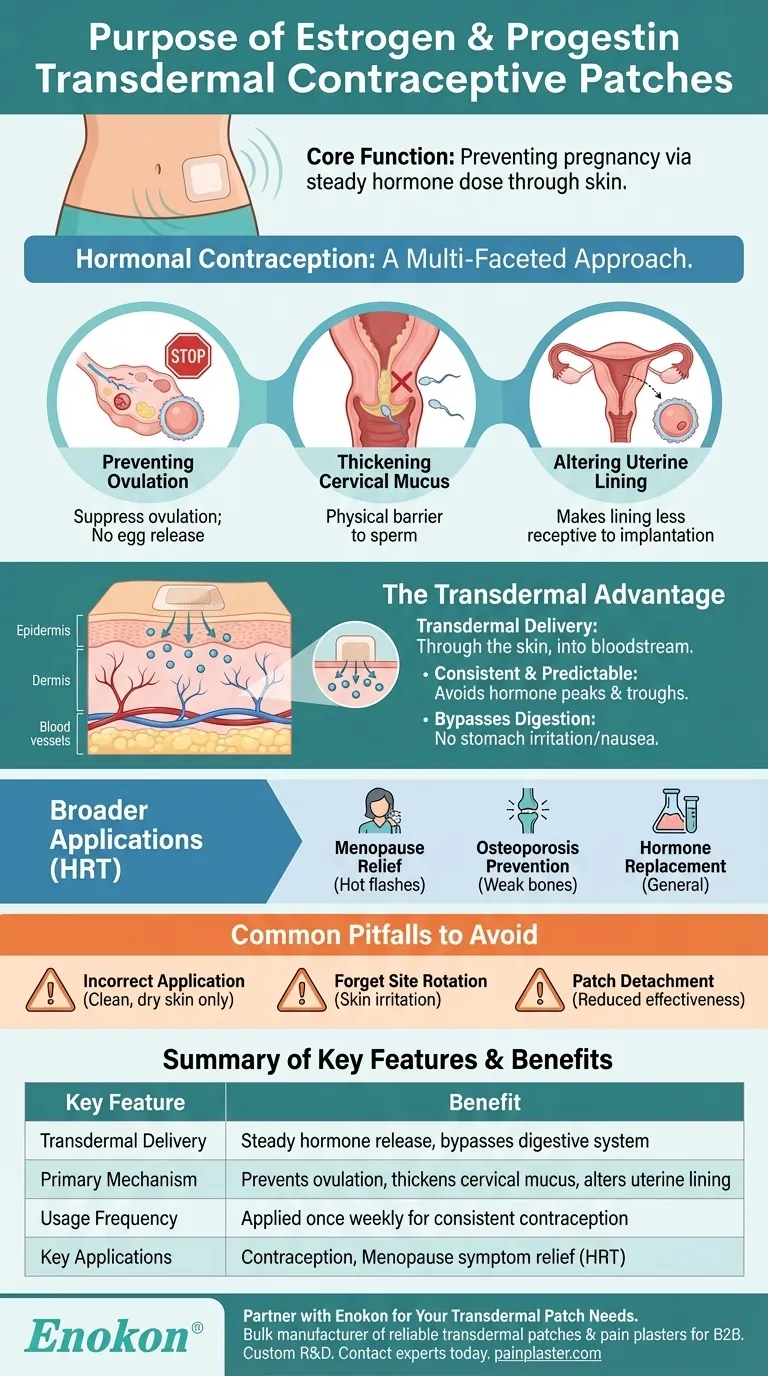At its core, an estrogen and progestin transdermal contraceptive patch is a method for preventing pregnancy. It works by delivering a steady dose of hormones through the skin to prevent ovulation (the release of an egg), thicken cervical mucus to block sperm, and alter the uterine lining to make implantation unlikely.
The patch leverages transdermal technology to provide a convenient, non-daily form of hormonal contraception, delivering a consistent dose of medication directly through the skin to bypass the digestive system.

How Hormonal Contraception Works
To understand the patch, you first need to understand its active ingredients. The combination of estrogen and progestin hormones prevents pregnancy through a multi-faceted approach.
Preventing Ovulation
The primary mechanism of action is the suppression of ovulation. The consistent supply of hormones signals to your body that it does not need to release an egg from the ovaries each month. Without an egg, fertilization cannot occur.
Altering Cervical Mucus
The hormones also cause the mucus in the cervix to thicken. This thicker mucus creates a physical barrier that makes it significantly more difficult for sperm to travel through the cervix and reach an egg, should one be released.
Changing the Uterine Lining
Finally, the hormones change the lining of the uterus, also known as the endometrium. This change makes the lining less receptive to a fertilized egg, preventing it from implanting and developing.
The Transdermal Patch as a Delivery System
The most significant aspect of the patch is not just the hormones, but how they are delivered into your body.
The Advantage of "Transdermal" Delivery
Transdermal simply means "through the skin." The patch contains a reservoir of medication that is absorbed slowly and consistently into the bloodstream over a set period, typically one week.
Consistency and Predictability
This method provides a smoother, more predictable delivery of hormones compared to a daily pill, which can cause hormone levels to peak and trough. A steady dose can lead to a better overall experience for some users.
Bypassing the Digestive System
Because the medication is absorbed through the skin, it avoids the digestive tract. This can be a major benefit for individuals who experience nausea or other gastrointestinal side effects from oral medications.
Broader Applications of Hormone Patches
While the combination patch is for contraception, the transdermal delivery of hormones is used for several other medical purposes, primarily related to hormone replacement therapy (HRT).
Managing Menopause Symptoms
Estradiol transdermal patches are commonly used to treat symptoms of menopause, such as hot flashes, night sweats, and vaginal dryness.
Preventing Osteoporosis
In postmenopausal women, estrogen patches can also be prescribed to prevent osteoporosis, a condition that causes bones to become weak and brittle.
General Hormone Replacement
These patches serve as a source of estrogen for women who do not produce enough of the hormone naturally for reasons other than menopause.
Common Pitfalls to Avoid
While convenient, the effectiveness and safety of the patch depend on proper usage.
Incorrect Application
The patch must be applied to clean, dry, intact skin. It should be placed on the lower abdomen or upper buttock, avoiding the breasts and waistline where clothing could rub it off.
Forgetting to Rotate Sites
To prevent skin irritation, it is critical to rotate the application site each time you apply a new patch. Applying it to the same spot repeatedly can cause redness or a rash.
Patch Detachment
If a patch becomes partially or fully detached for an extended period, it may not deliver the correct dose of medication. This can reduce its contraceptive effectiveness, requiring the use of a backup birth control method.
Making the Right Choice for Your Goal
Understanding the technology helps you determine if a patch is the right tool for your specific health objective.
- If your primary focus is preventing pregnancy: The patch offers a highly effective, non-daily hormonal option that eliminates the need to remember a daily pill.
- If your primary focus is managing menopause: A hormone patch can provide consistent, steady relief from disruptive symptoms like hot flashes and vaginal dryness.
- If your primary focus is convenience and avoiding side effects: The transdermal system bypasses the digestive tract, offering a significant benefit if you are sensitive to oral medications.
Ultimately, the transdermal patch is a versatile tool for delivering medication steadily and conveniently through the skin.
Summary Table:
| Key Feature | Benefit |
|---|---|
| Transdermal Delivery | Steady hormone release, bypasses digestive system |
| Primary Mechanism | Prevents ovulation, thickens cervical mucus, alters uterine lining |
| Usage Frequency | Applied once weekly for consistent contraception |
| Key Applications | Contraception, Menopause symptom relief (HRT) |
Partner with Enokon for Your Transdermal Patch Needs
As a bulk manufacturer of reliable transdermal patches and pain plasters, Enokon provides healthcare and pharmaceutical distributors and brands with the technical expertise for custom R&D and development. Ensure your products deliver consistent, effective hormone therapy with our advanced transdermal technology.
Contact our experts today to discuss your project requirements.
Visual Guide

Related Products
- Prostate Pain Kidney Health Care Patch for Men
- Far Infrared Heat Pain Relief Patches Transdermal Patches
- Far Infrared Deep Heat Relief Patches Medicated Pain Relief Patches
- Asthma Cough and Pain Relief Patch for Adults and Kids
- Heating Pain Relief Patches for Menstrual Cramps
People Also Ask
- What is the purpose of testosterone patches? A Steady Solution for Low Testosterone
- What should be done if a testosterone patch falls off? A Guide to Maintaining Hormone Stability
- What should be done if a dose of testosterone patches is missed? Regain Stability and Safety
- What precautions should be taken when applying testosterone patches? Maximize Safety and Effectiveness
- What should be done if a testosterone patch is missed or falls off? Follow these simple timing rules for safety and consistency.













